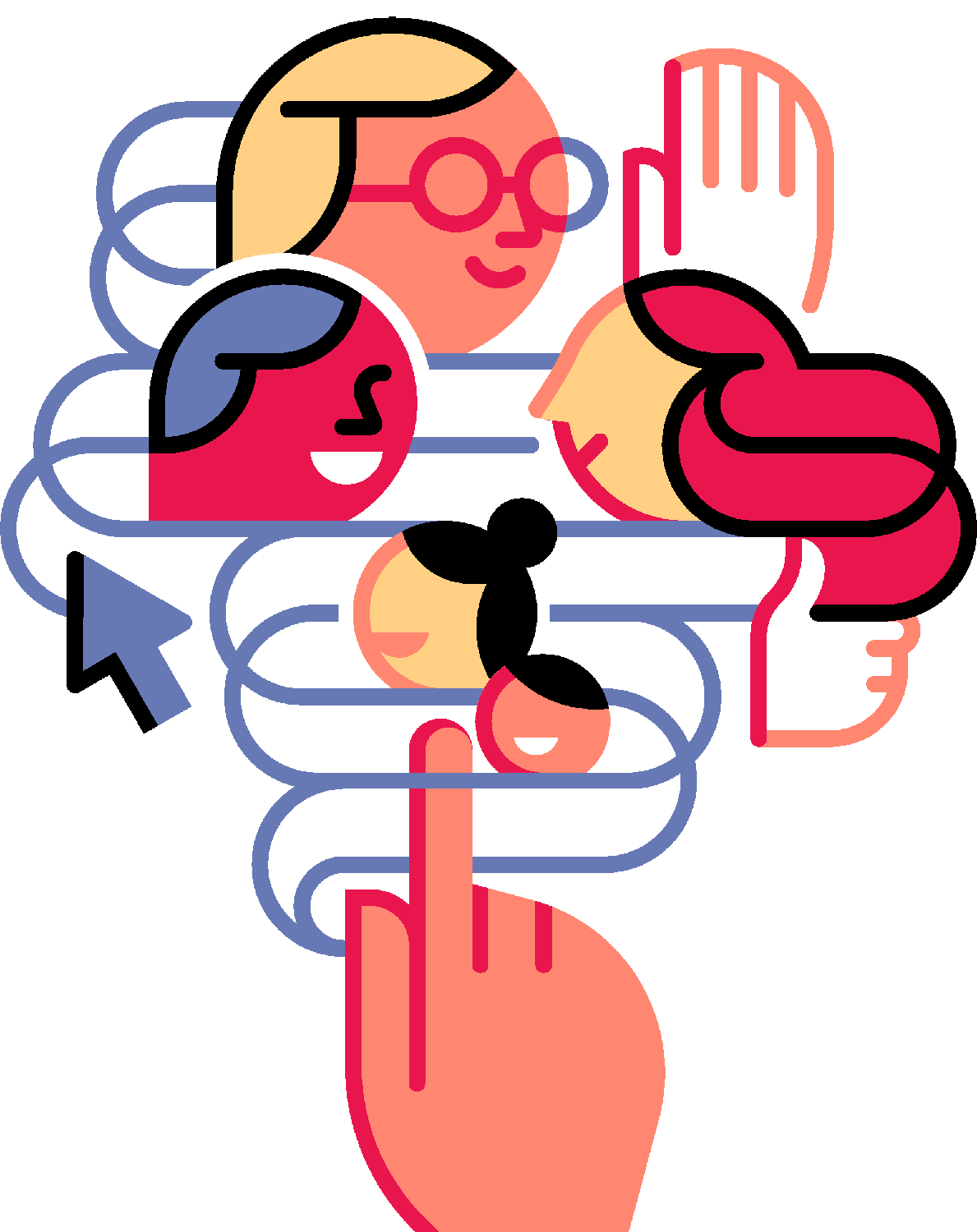Making new friends, virtually
Illustrations by Carlos Arrojo
Forging friends as an adult can be a challenging task – and even more so for teens, young adults, and those navigating life transitions. Outside of everyday work or school environments, the available time and opportunities to encounter new individuals and cultivate friendships are restricted for many. It can be isolating and daunting to navigate a desire to meet new people alongside your practical restraints. But humans are inherently social beings and, since the dawn of time, being in a community has been essential to human survival. A strong friendship brings joy and a level of fulfillment to people’s lives.
In the Netflix docuseries Live to 100: Secrets of the Blue Zones, author Dan Buettner explores global communities with a thriving centenarian population. Beyond eating a surplus of sweet potatoes and other health-conscious dietary choices, Dan learns that part of the reason many of these communities live such long and thriving lives is because of their community and close-knit societies. This is particularly true for younger people as studies show social connection plays a key role in emotional development and long-term mental health.
On the flipside, not being part of a cohesive unit or having a strong support system can be incredibly isolating and may even have physical repercussions. A 2010 study on social relationships and mortality risks created waves when it announced a 50% higher likelihood of survival for people with robust social connections versus those with weaker connections or lack thereof.
While the profound influence of friendship on one's well-being is evident, many individuals lack the time to actively seek out new friends. According to a study by associate professor of communication studies Jeffrey Hall, it takes nearly 50 hours spent with another person to move from acquaintance to a casual friend and a whopping 200 hours to be considered a semi-close friend. For young people juggling school, extracurricular activities, and jobs, carving out those hours can feel overwhelming.
Fortunately, the surge in social media has provided a plethora of apps, websites, and digital communities to help develop friendships readily available at our fingertips. Take Geneva, for example. Similar to Meetup.com, Geneva is a digital platform where you can join group chats, talk amongst people with similar interests, and find and plan events in your area. These resources make making friends and mingling with people in your perimeter much more attainable and less intimidating. For younger users, platforms like Discord and interest-based group chats serve as accessible, low-pressure ways to connect with like-minded peers. Common Sense Education has a dynamic list of suggestions for online groups geared toward kids and youth.
Carlos Arrojo
Anna Goldfarb, an author, journalist, and expert on the mechanics of friendship, believes that digital platforms can serve as efficient tools for [people] aiming to broaden their social connections. “One of the biggest draws of friendship is to explore common interests and hobbies together. Online platforms are fantastic at bringing people together who have these passions.”
After hearing about a handful of Bumble BFF success stories, I finally decided to take the plunge and give it a try. While swiping, you evaluate a prospective friend based on a handful of photos, a brief bio, and their Instagram presence if you're lucky enough to have access. Despite the limited information, I took the leap of faith and met for coffee with one of my matches. To my shock, it was successful, and I developed a strong friendship.
My Bumble BFF experience prompted me to reflect on the nature of friendships and ask the question: can a friendship be considered substantial if it's limited to online interactions and doesn't involve meeting in person? According to Goldfarb, “Online friendships are a great side dish, but they shouldn’t be the main course. Looking into your friend’s eyes, hearing their laugh, hugging one another, responding to each other’s body language — those are all the benefits of an in-person hang out. Being in the same room as your friend increases the chance of making happy memories together, which will power your friendship for a long time.”
Carlos Arrojo
Additionally, when asked about the downside of online friendships, Goldfarb shared, “One of the cons of online friendships is that tone is very hard to convey over text or email. And online friendships don’t lend themselves to making happy memories in the way IRL friendships do.” So before you get too comfortable in the talking stage of your blooming online friendships, take it upon yourself to plan an in-person get-together.
Before joining these digital platforms and communities, knowing what you are looking for in a friend is essential. If you are unsure, take some time to reflect and journal about what is missing in your life and what you want to call in. What qualities do you admire most in people? How can a new friend positively impact your life and vice versa? If you want to expand your network, make the most out of the resources around you.
For younger people, this might mean exploring school clubs, youth groups, or volunteer opportunities. Use localized Instagram hashtags, look up events in your area, utilize apps, and engage in new activities that push you beyond your comfort zone. Keep an open mind and learn to say yes to things. Through exploring hobbies and activities, you may meet people that you never thought you could click with before and open the door to flourishing friendships.
Mhaya Polacco is an award-winning writer and comedian based in Los Angeles. Her work, inspired by relationships, mental health, and life's awkwardness, has been featured in Sweety High, Flexx Magazine, and more. With over 30 film festival recognitions, she’s currently in production for a short comedy film. When she's not on set, you can catch her performing stand-up comedy at clubs around LA or creating viral content for brands' social media platforms.
your contribution is tax-deductible




